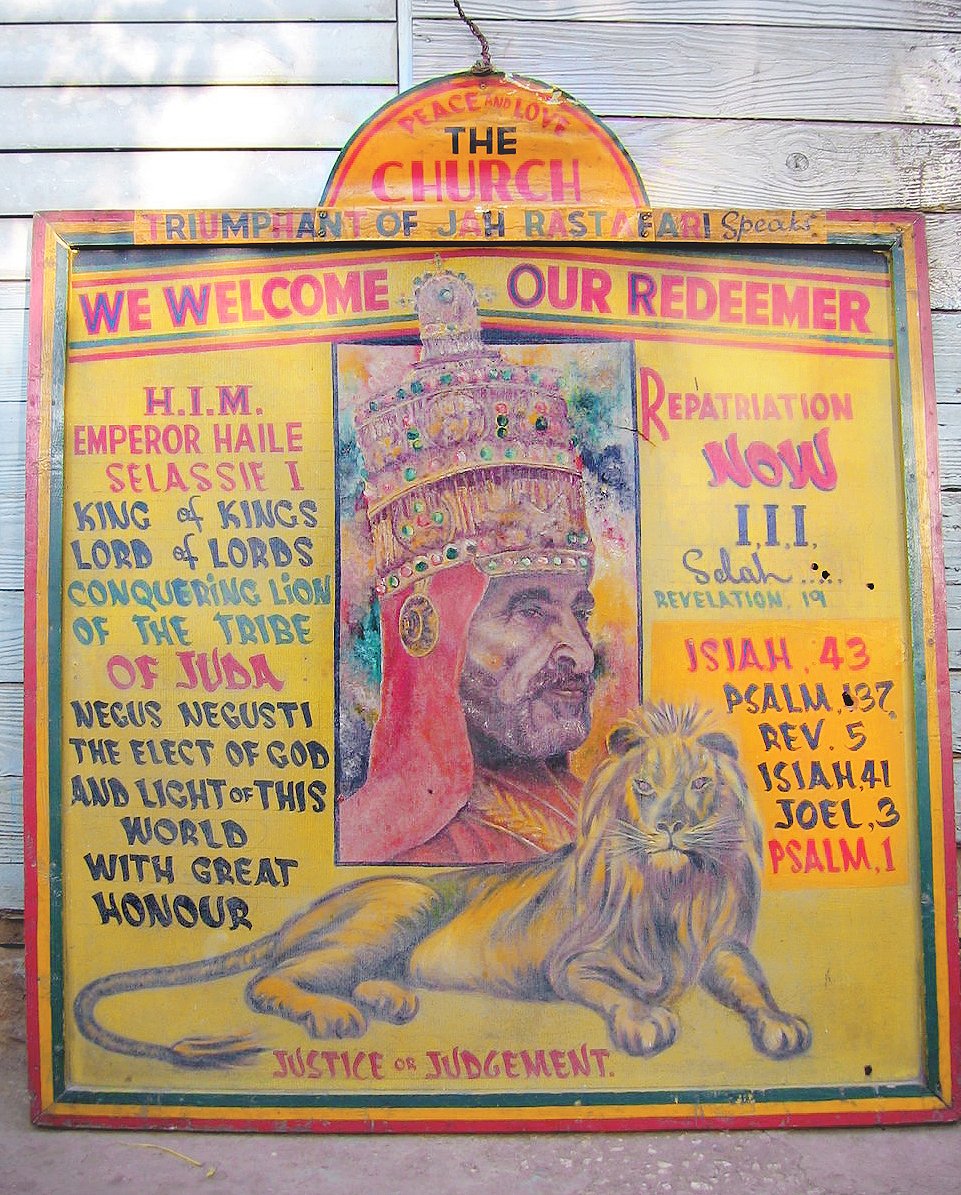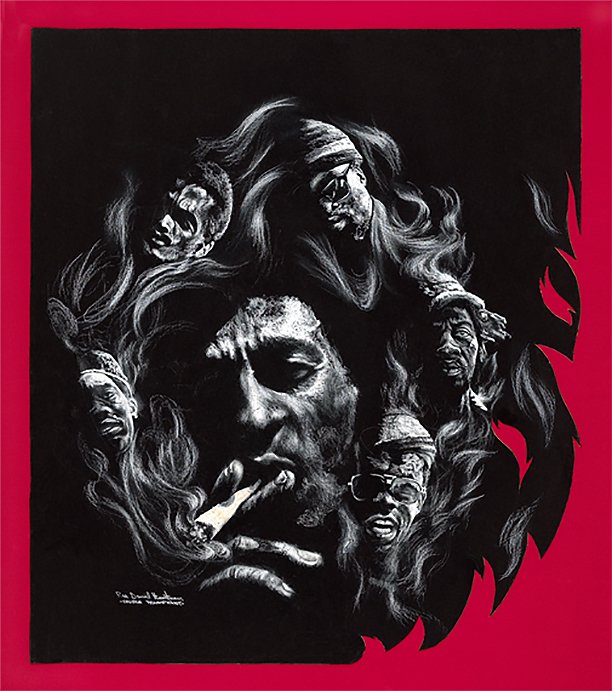Ras Daniel Heartman at Lime Cay beach in Jamaica. Still from the 1972 Jamaican film The Harder They Come
Ras Daniel Heartman, formerly Lloyd George Roberts, was born January 18, 1942 in Kingston, Jamaica. As a child, he had a love of art in all forms—from visual to performance and saw his attempts to master multiple genres. It soon became clear that his brilliance was undeniable. A man of many talents, he won dance competitions at the Majestic Theater before he went on to stun the world with his images.
Ras Daniel Heartman, Kingston, Jamaica, 1973. Photo by Jamaican actress and photographer Esther Anderson. ©️1973 Esther Anderson
At 16 years old, Heartman embraced Rastafari and frequently visited many of their legendary Rastafari settlements in West Kingston, including Back O' Wall (present day Tivoli Gardens). After being recruited by a prominent member of the Church Triumphant of Jah Rastafari, he left home in Whitfield Town to commit to the movement. The Church Triumphant, recognized the strength and utility of his art as a tool to inspire others, and to promote the dissemination of the Rastafari faith. He was called the "Walking Camera" because of the realistic and detailed quality of his portraits. It was at that point that he renamed himself "Ras Daniel Heartman" defining "Heartman" as "man of the heart". Young Daniel emerged as a central figure among the group, and he was known for his outspokenness, sharp reasoning, assertiveness, fearlessness, and strong will. The group held street meetings and gatherings in the 1960's preaching the divinity of His Imperial Majesty Emperor Haile Selassie I, highlighting the "downpression" of the people of Jamaica, and calling for repatriation to Africa.
Man I, eldest son of Heartman, as "Rupert" sitting on the railroad tracks in a scene from the 1972 iconic Jamaican film The Harder They Come
By 1958 Heartman began taking his art seriously, working primarily in pencil, pen and ink drawing, along with oil painting. He created dance posters and signboards for quick cash in order to support his family, while he continued to work on his less commercial and more personal pieces. His popularity quickly grew throughout Kingston and before long, he emerged as one of Jamaica's leading and most sought after portrait artists. He sold original pieces to both Jamaicans and foreigners. Eventually, he began printing his work, which brought him an even larger audience nationally. In addition to his visual art work, he was also known for his popular high-crowns, which he made using leather and other fabrics.
Front and back of the Ethiopian Gold Coronation Medal that was gifted to Ras Daniel Heartman by His Imperial Majesty Emperor Haile Selassie the 1st on the Ethiopian Monarch's state visit to Jamaica in 1966. Copyright ©️2017 From the Archives of the RDH Estate
An important part of Rastafari history, Heartman participated in His Imperial Majesty Emperor Haile Selassie’s meaningful visit to Jamaica on the 21st of April, 1966. Daniel created a 4 X 4 placard on wood of His Majesty in coronation attire, which was used to welcome the Emperor at the airport in Kingston. The piece has been put on display at the Smithsonian "Discover Rastafari" exhibition that ran from November 2, 2007 until November 16, 2011. In addition, during his three-day visit, His Majesty gave gold coronation medals to thirteen exemplary Rastafari individuals, including Ras Daniel. On receiving his coronation medal at King's House on the 22nd April, 1966, the artist in turn gifted the Ethiopian Emperor with an oil painting of the likeness of His Imperial Majesty Emperor Haile Selassie I in military uniform. Upon receiving Heartman’s gift, the Ethiopian Monarch is said to have uttered the words: "Well done my son, well done.”
Placard painted by Ras Daniel Heartman to welcome the historic visit of Emperor Haile Selassie the 1st to Jamaica in 1966.
In the late 1960's Jamaican Producer Perry Henzell, co-wrote and directed the first Jamaican full-length feature film, "The harder they come" and along with Chris Blackwell of Island Records (who produced the soundtrack), went in search of Ras Daniel Heartman. Following a quick audition, Heartman and his eldest son were cast in the groundbreaking film. He was a natural choice due to his charisma and already popular persona. The film was released in 1972 and has been credited with taking reggae music to the international stage, it also cemented Ras Daniel Heartman’s position as the first Rastafari ever to be seen in global popular culture. His fame grew due to his seminal role in the movie, and it propelled his artwork to international markets.
Jimmy Cliff as Ivan and Ras Daniel Heartman as Pedro in The Harder They Come
Man I as "Rupert", Ras Daniel Heartman as "Pedro" and Jimmy Cliff as " Ivanhoe Martin" by the ocean in Lime Cay, Jamaica. Scene from the film The Harder They Come that was released in 1972
Heartman now became not only an international symbol of Rastafari, but also an important part of the canon of Caribbean art. Despite his irrepressible contributions, Heartman was not embraced by the Jamaican art establishment. But, on july 29, 1980 he was awarded The centenary medal (1879-1979) by The Council of the Institute of Jamaica, headed by the then chairman John Hearne, in recognition of his "sustained and outstanding contribution to cultural development in Jamaica in the field of Art"
Jamaican reggae Singer-Songwriter Winston Hurbert McIntosh(Peter Tosh) wearing a shirt with the artwork "Not Far Away" by Ras Daniel Heartman, with fellow musician Bunny Wailer on Bunny's farm. Hector's River, Portland Jamaica 1978. Both were original members of the reggae group The Wailers along with Bob Marley. Photo by Adrian Boot Copyright ©️1978 Adrian Boot/ UrbanImagetv
The 1980's marked a significant point in Heartman's evolution. His profound interest in metaphysics, anatomy, astronomy, and in the Ancient Egyption civilization led him to create eclectic and stunningly complex pieces. An avid collector and lover of books, this period of intense intellectual, spiritual, and artistic growth saw Heartman reading voraciously and learning both Hieroglyphics and Amharic.
Even as Heartman ventured into new intellectual spaces, his commitment to repatriation never wavered. He repatriated to Africa in the late 1980's. With the support of the Universal Rastafari Improvement Association (U.R.I.A.), a UK-based organization, he made Tanzania the Zion of which he had dreamed of. Sadly, Ras Daniel Heartman joined the ancestors on 31st of May, 1990, a year and 7 months after fulfilling the dream of repatriation.
Keith Richards of the English rock band The Rolling Stones wearing a shirt with the artwork "Prince Emanuel" by Ras Daniel Heartman at his home in Weston, Connecticut on January 1, 1977. Photo by Ken Regan/Camera. Contour by Getty Images
The world lost a unique and irreplaceable artist when Heartman transitioned at 47 years old. But, his legacy lives on in the iconic images that are treasured by so many. images such as Prince Emanuel "Rasta Baby", "Princess Desta" and "Not Far Away" capture the greatness and soul of an artist that will live forever.
Legendary Reggae singer and songwriter Robert Nesta Marley wearing a shirt of "Daniel in the Lion's Den" by Ras Daniel Heartman as he steps off the plane in Zurich, Switzerland, 1980
Catch A Fire album cover- The Wailers 1973 (original unreleased version)









